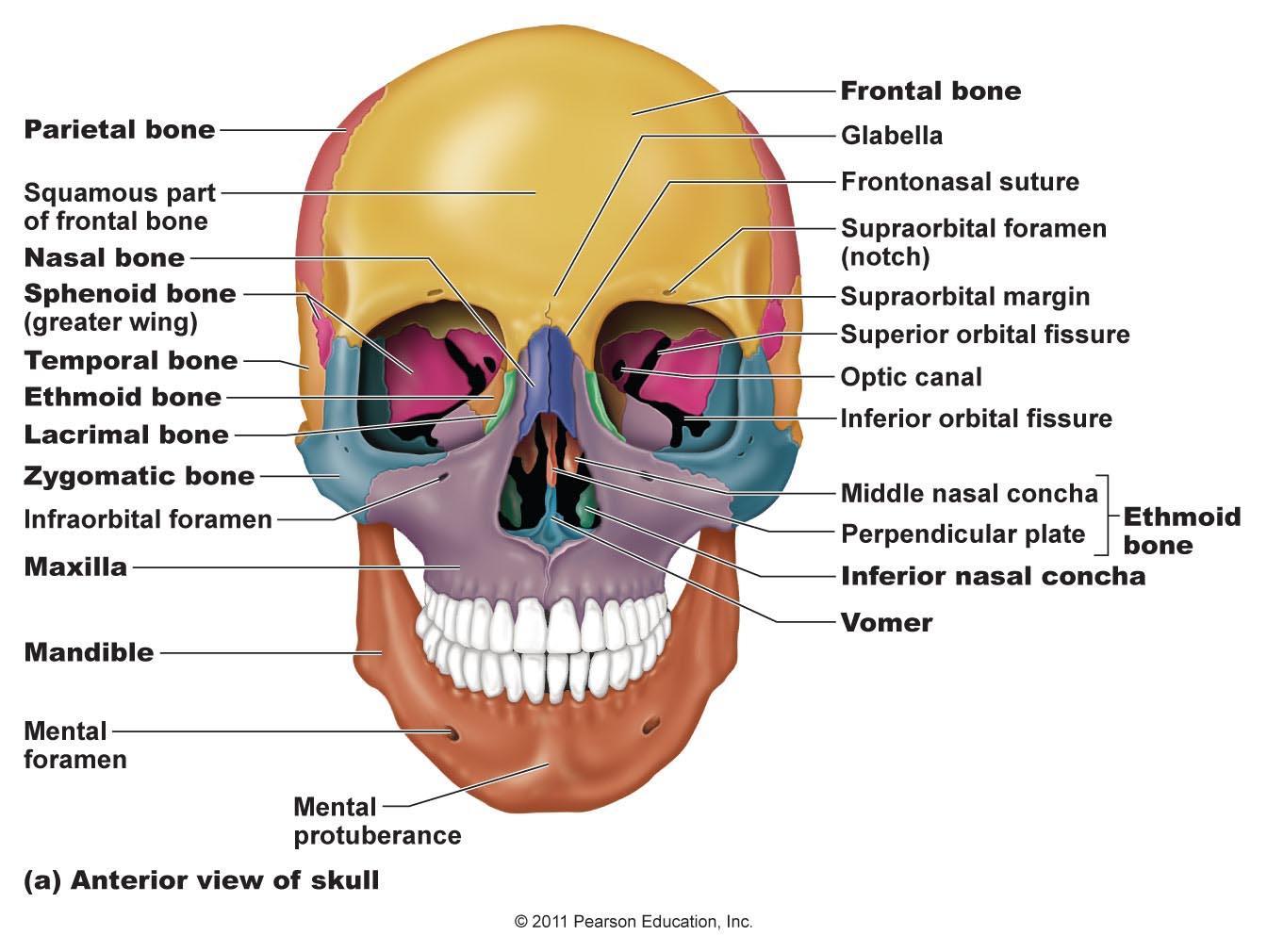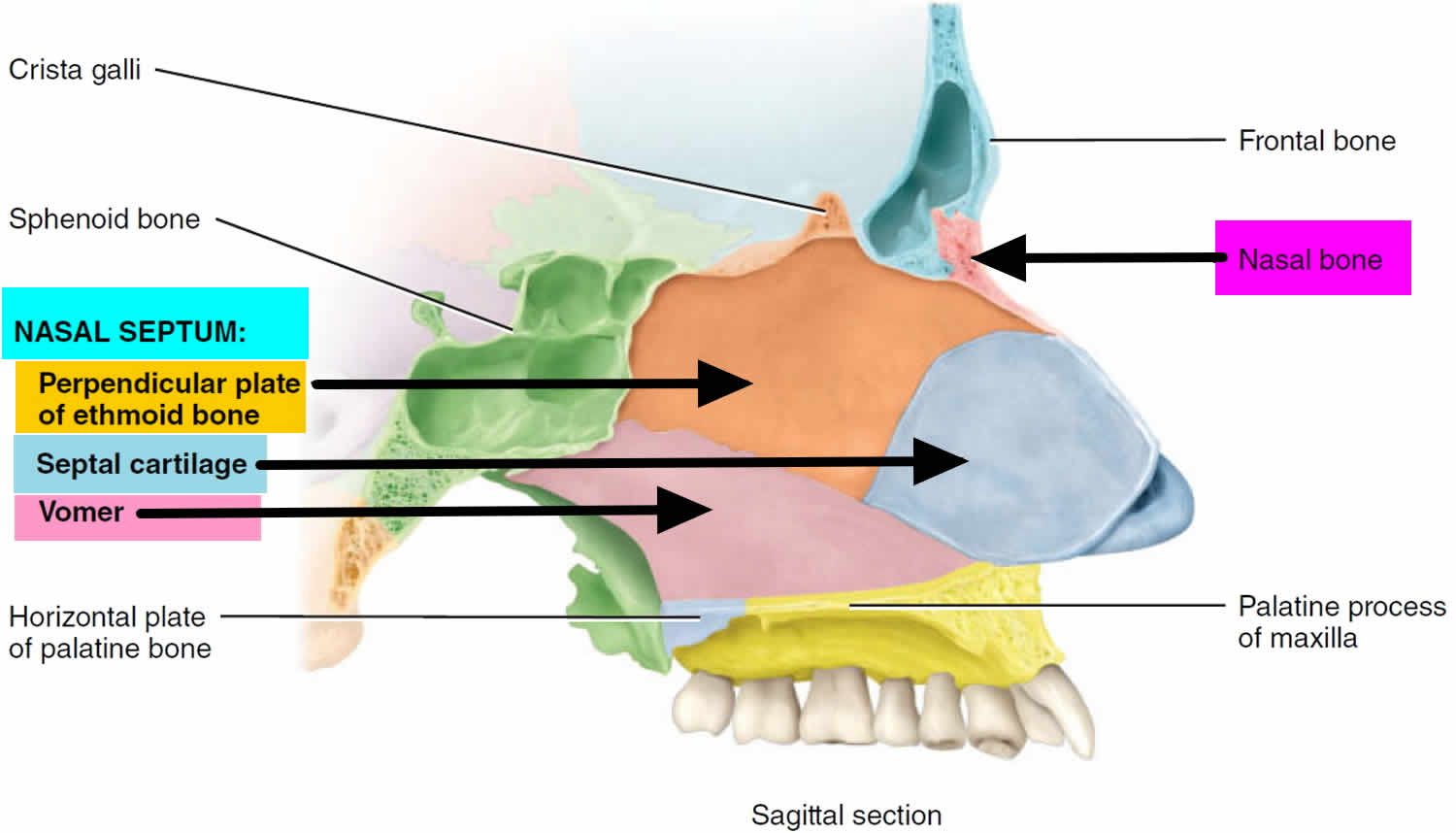What Bones Form The Nasal Septum
What Bones Form The Nasal Septum - Web the bones that contribute to the nasal septum can be divided into: Ethmoid and vomer which bone of the axial skeleton does not have a direct connection to any other bone? Perpendicular plate of ethmoid bone, vomer bone, cartilage of the septum, crest of the maxillary bone, and crest of the palatine bone. Branches of the sensory anterior ethmoidal nerve innervate the skin of the sides of the nose, the septum, and the inner surfaces of the nasal cavity. The septal cartilage sits on top of the vomer bone and in front of the ethmoid bone, which it joins further back. It runs down the center of your nose and separates the two nasal cavities. A badly deviated septum may cause breathing problems, congestion and headaches. The roof of a building. Nasal, maxillary, and palatine bones. It is made up of the septal cartilage, the vomer bone, and the perpendicular plate of the ethmoid bone.
None the nasal bone is a small, flat bone of the skull. It runs down the center of your nose and separates the two nasal cavities. When looking into the nasal cavity from the front of the skull, two bony plates are seen projecting from each lateral wall. The bones of your nose are known as the nasal septum. Perpendicular plate of ethmoid bone. Anteriorly the septal cartilage (quadrangular cartilage) approximates a quadrilateral shape. Crest of the palatine bone Web the external part of the nose consists of a root (superiorly), apex (inferiorly), dorsum, nares. Each side of the nasal cavity is triangular in shape, with a broad inferior space that narrows superiorly. The horizontal plate of the palatine bone posteriorly and the palatine process of the maxilla anteriorly.
None the nasal bone is a small, flat bone of the skull. It is said by some authors that the nasal septum is the “cornerstone” of the nose. Web the nasal septum is composed of five structures: Web nasal septum is composed of five structures: Nasal, maxillary and palatine bones unpaired bones: The nose is divided into two sides by the septum. It is made up of the septal cartilage, the vomer bone, and the perpendicular plate of the ethmoid bone. The ethmoid and vomer bones are unpaired. Web carey nease, lindsay sturm, in rhinoplasty, 2023 nasal septum the nasal septum is a midline structure of the nose that has connections to all structures; Web which bones make up the nasal septum, which divides the left nostril from the right?
Deviated Septum Causes, Symptoms, How To Fix A Deviated Septum
Surgery can repair a deviated septum. It makes up the facial skeleton ( viscerocranium) along with the zygomatic bone, maxillae, palatine bones, lacrimal bones, inferior nasal conchae, vomer and mandible. The most anterior part of the nasal cavity is the nasal vestibule. The bones of the nose, forehead, sphenoid, and ethmoid are what make up the nose. Web the nasal.
Anatomy of nasal septum. Download Scientific Diagram
Web the nasal bones form the roof, while the frontal process of the maxilla and lacrimal bone forms the sides of the nose. For others, a nose injury causes it. Is nasal septum a bone? Web overview symptoms when to see a doctor causes risk factors complications prevention overview a deviated septum occurs when the thin wall (nasal septum) between.
nasal complex bones Google Search Nasal septum, Nasal cavity
Surgery can repair a deviated septum. Web the fleshy external end of the nasal septum is sometimes also called columella. Is nasal septum a bone? Anteriorly the septal cartilage (quadrangular cartilage) approximates a quadrilateral shape. The septal cartilage sits on top of the vomer bone and in front of the ethmoid bone, which it joins further back.
Deviated Septum Causes, Symptoms, How To Fix A Deviated Septum
Web the floor of the nasal cavities, which also form the roof of the mouth, is made up by the bones of the hard palate: It is said by some authors that the nasal septum is the “cornerstone” of the nose. The larger of these is the inferior nasal concha, an independent bone of the skull. Web the nasal septum.
Bones Forming Nasal Cavity Medial Wall Of The Nasal Cavity Anatomy
Web the upper portion of the nasal septum is formed by the perpendicular plate of the ethmoid bone and the lower portion is the vomer bone. The septal cartilage sits on top of the vomer bone and in front of the ethmoid bone, which it joins further back. When looking into the nasal cavity from the front of the skull,.
Vomer Bone In Nose The primary bone in the septum of the nose is
Web the vertical midline nasal septum is comprised primarily of a single nasal cartilage from the external nose and two bones. The larger of these is the inferior nasal concha, an independent bone of the skull. Nasal, maxillary, and palatine bones. Web the upper portion of the nasal septum is formed by the perpendicular plate of the ethmoid bone and.
Nasal septum anatomy, function, nasal septum deviation & hole
It is said by some authors that the nasal septum is the “cornerstone” of the nose. Departure of the nasal septum from the center line of the nose. The bones contributing to the formation of the nasal septum can be classified as paired or unpaired. None the nasal bone is a small, flat bone of the skull. The horizontal plate.
Nasal Cavity Definition, Anatomy, Functions, Diagrams
When looking into the nasal cavity from the front of the skull, two bony plates are seen projecting from each lateral wall. Perpendicular plate of ethmoid bone; Some people are born with a deviated septum. The anterior portion of the nasal septum is made of irregular quadrangular hyaline cartilage that inserts into the nasomaxillary crest of the maxilla and nasal.
Pin on Learn Anatomy
It is made up of the septal cartilage, the vomer bone, and the perpendicular plate of the ethmoid bone. Web the nasal septum is composed of bones and cartilage covered with a mucous membrane called squamous epithelium. Web the upper portion of the nasal septum is formed by the perpendicular plate of the ethmoid bone and the lower portion is.
Nasal Cavity arterial supply and nasal meatuses and chonchae
It runs down the center of your nose and separates the two nasal cavities. Some people are born with a deviated septum. Perpendicular plate of ethmoid bone. Web carey nease, lindsay sturm, in rhinoplasty, 2023 nasal septum the nasal septum is a midline structure of the nose that has connections to all structures; A badly deviated septum may cause breathing.
The Nasal Septum Contains Bone And Hyaline Cartilage.
The bones of your nose are known as the nasal septum. It is said by some authors that the nasal septum is the “cornerstone” of the nose. Posteriorly it meets the concave anterior margins of the ethmoid and vomer. Branches of the sensory anterior ethmoidal nerve innervate the skin of the sides of the nose, the septum, and the inner surfaces of the nasal cavity.
Each Side Of The Nasal Cavity Is Triangular In Shape, With A Broad Inferior Space That Narrows Superiorly.
Web the nasal bones form the roof, while the frontal process of the maxilla and lacrimal bone forms the sides of the nose. Crest of the palatine bone Ethmoid and vomer which bone of the axial skeleton does not have a direct connection to any other bone? Web os nasale 1/7 synonyms:
The Bones Contributing To The Formation Of The Nasal Septum Can Be Classified As Paired Or Unpaired.
The nasal septum is composed of five structures: Web the external part of the nose consists of a root (superiorly), apex (inferiorly), dorsum, nares. The bones of the nose, forehead, sphenoid, and ethmoid are what make up the nose. Departure of the nasal septum from the center line of the nose.
The Larger Of These Is The Inferior Nasal Concha, An Independent Bone Of The Skull.
The nasal septum is made up of cartilage and bone. It is made up of the septal cartilage, the vomer bone, and the perpendicular plate of the ethmoid bone. This groove is where the lacrimal sac resides. It makes up the facial skeleton ( viscerocranium) along with the zygomatic bone, maxillae, palatine bones, lacrimal bones, inferior nasal conchae, vomer and mandible.









